How often to water potatoes is a common concern among gardeners seeking to maximize their crop’s health and yield. Read on to know expert advice and insights on how often to water potatoes, when to stop watering potatoes and the importance of watering potatoes. Let’s dive into it!
Contents
How to Know That It’s Time to Water Plants?
Let’s look at how to know that its time to water the potato crop below:
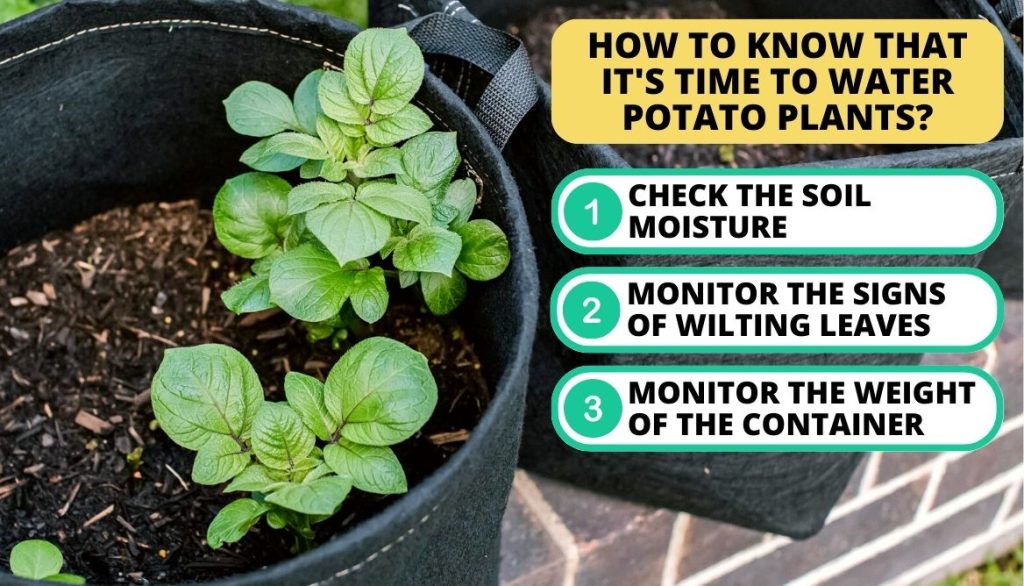
- Soil moisture: Check the soil moisture by sticking your finger about an inch. If it feels dry at that depth, it’s time to water the plants.
- Wilting leaves: Monitor the potato growing process for signs of wilting or drooping leaves, as this can indicate a lack of water and the need for watering.
- Container weight: Keep an eye on the weight of the container or pot. If it feels noticeably lighter than when it was watered, it indicates that the plants need watering.
How Often to Water Potatoes?
Potatoes typically require regular watering, especially during the growing season. Watering them deeply once or twice a week is recommended, depending on the weather conditions.
However, monitoring the soil moisture and adjusting the watering frequency is essential.
How Much Water Do Potatoes Need?
The water requirements for potatoes vary depending on various factors such as weather conditions, soil type, and growth stage. However, here are some general guidelines for watering potatoes in both garden and containers:
1. In the Garden
Let’s look at how much water is needed in the garden to water potatoes below:
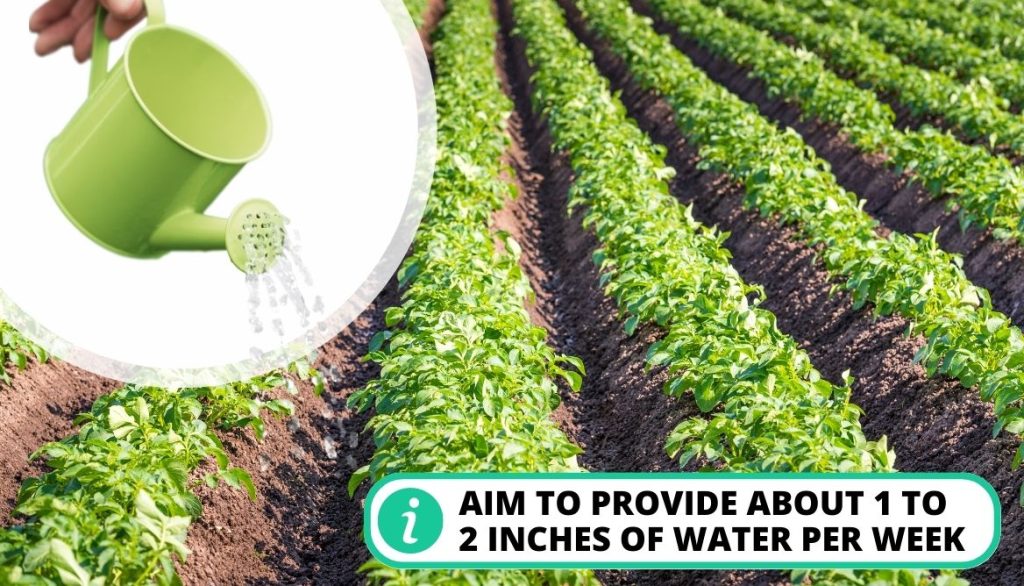
- Newly planted potatoes: After planting potatoes, water the soil thoroughly to ensure even moisture to seed potatoes. Keep the soil moist but only waterlogged once the young potato plants establish their root systems.
- During the growing season: Potatoes require regular watering, especially during dry periods. Aim to provide about 1 to 2 inches of water per week. However, adjust this amount based on the weather conditions and the moisture levels in the soil.
2. In a Container
Potatoes grown in containers generally require consistent watering to ensure proper growth and yield. As a general guideline, containers should be watered thoroughly when the top inch of the soil feels dry to the touch.
The goal is to keep the soil moist but not overly saturated to avoid waterlogged conditions that can lead to root rot.
How to Water Potatoes – The Process
Watering potatoes involves two main stages: the first stage, which occurs when you plant potatoes, and the second stage, which takes place during the tuber formation and growth. Here’s a breakdown of the watering process for potatoes in each stage:
First Stage: Growth and Establishment
Below is a guideline for the process of how to water potatoes for the first stage:
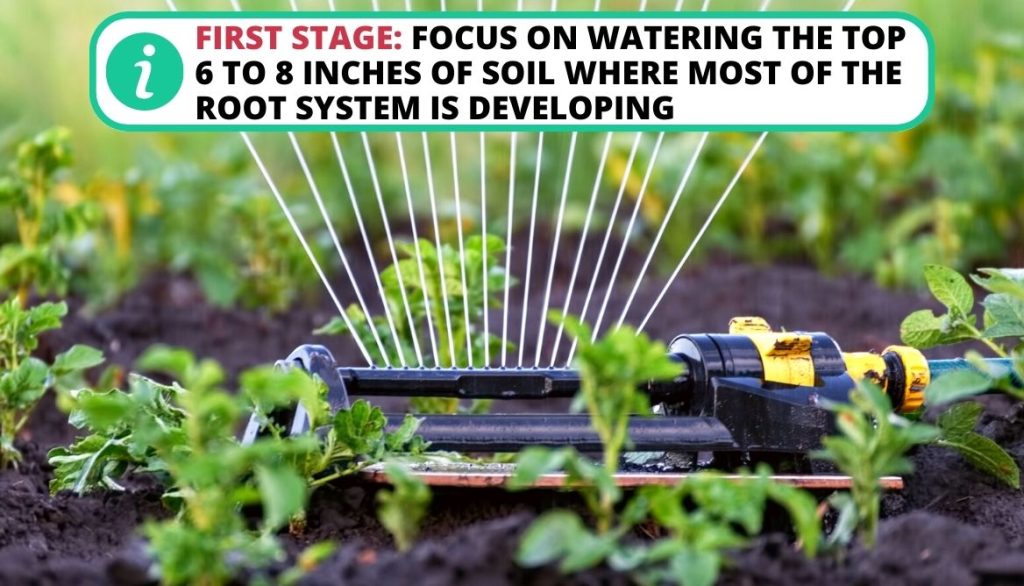
- Plant potatoes: Begin by preparing planting soil. Potatoes prefer well-draining soil, so ensure the soil is loose and not compacted. Create furrows or mounds for planting the seed potato pieces.
- Initial watering: After planting the seed potatoes or pieces, provide a thorough initial watering to help settle the soil and promote germination. Ensure that the wet soil is evenly but not waterlogged.
- Monitoring moisture: Regularly monitor the moisture levels in the soil during the initial growth phase. Potatoes require consistent soil moisture for optimal growth. Aim for consistently moist soil, but avoid overwatering, which can lead to rotting.
- Watering frequency: Depending on the weather conditions and soil moisture retention, you may need to water the potato crops every 2 to 3 days. However, it’s essential to adapt the watering schedule based on the specific requirements of your soil conditions and climate. Monitor the moisture content in the top few inches of soil and water accordingly.
- Depth of watering: During the first stage, focus on watering the top 6 to 8 inches of soil where most of the root system is developing. Ensure the water penetrates deeply enough to encourage the potato roots to grow downward.
Second Stage: Potato Tubers Formation and Growth
Below is a process on how to water potatoes in the second stage:
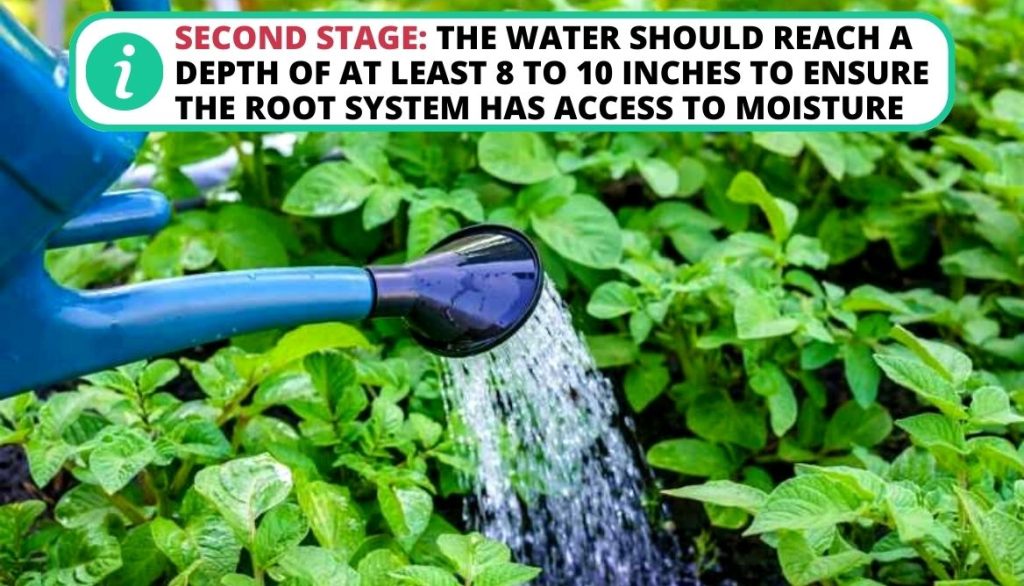
- Tuber formation: As the potato plants grow and produce foliage, they will eventually begin forming tubers beneath the soil surface. At this stage, providing consistent moisture to support tuber development is crucial.
- Moderate watering: Maintain regular watering during the tuber formation stage, aiming for a consistent but moderate moisture level. This helps prevent potato tubers from becoming overly dry or developing cracks.
- Watering interval: The watering frequency may remain similar to the first stage, around every 2 to 3 days, but again, adapt the schedule to suit your specific conditions. Regularly check the moisture levels in the soil to ensure it remains consistently moist.
- Deep watering: Pay attention to watering deeply enough to encourage the tubers to grow and mature properly. The water should reach a depth of at least 8 to 10 inches to ensure the root system has access to moisture.
- Reducing watering: As the potato plants approach maturity and the foliage begins to turn yellow and die back, gradually reduce watering. This process allows the tubers to harden off and facilitates easier harvest potatoes.
When To Stop Watering Potatoes
Knowing when to stop watering depends on the stage of growth and the time for harvesting potatoes you aim for. Here are some guidelines to help you determine when to stop watering potatoes:
- Vegetative stage: During the early stages of growth, potatoes focus on developing foliage and establishing a strong root system. Adequate water is important at this stage to support healthy growth. Water the plants consistently, ensuring the soil remains evenly moist.
- Flowering stage: As the plants mature, they will produce flowers. This stage is an indication that the tubers are beginning to form underground. Continue to water regularly, but avoid overwatering, as excessive moisture can lead to disease and rot.
- Tuber formation stage: Once the plants have finished flowering, the focus shifts from foliage growth to tuber development. At this stage, you should gradually reduce watering. Potatoes require less moisture during this phase, and reducing water availability can help promote tuber formation and prevent issues such as hilling potatoes or splitting.
- Maturation stage: Towards the end of the growing season, the potato plants will start to senesce, and the foliage will turn yellow and die back. This is a natural process indicating that the tubers have reached maturity. At this point, it is important to stop watering the plants to allow the tubers to harden and develop their full flavor and storage potential.
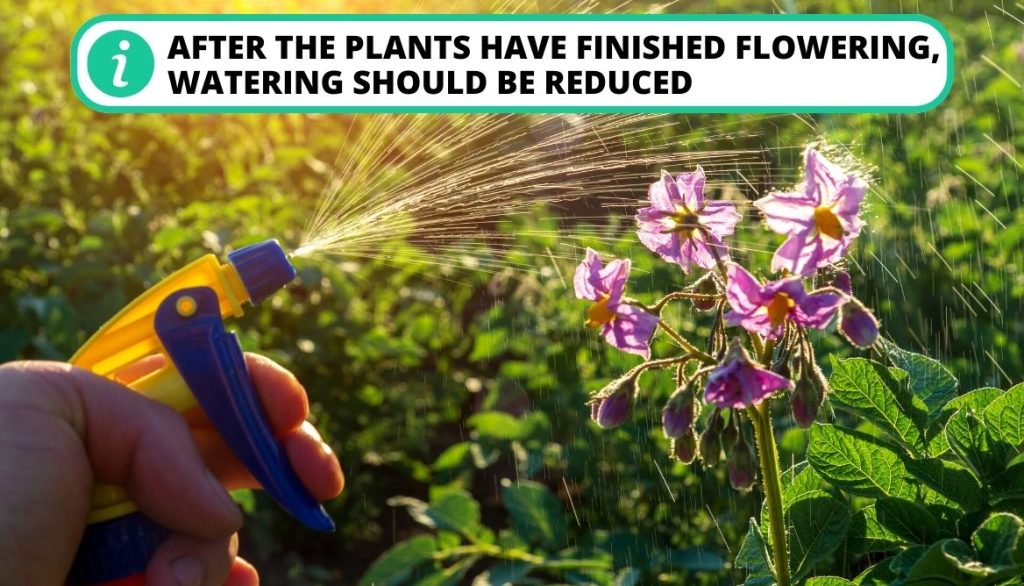
Importance Of Watering Potatoes Adequately
Watering potatoes adequately is crucial for their growth and overall health. Potatoes are a high-moisture crop that requires consistent watering throughout their growth cycle. Here are some reasons why watering potatoes adequately is important:
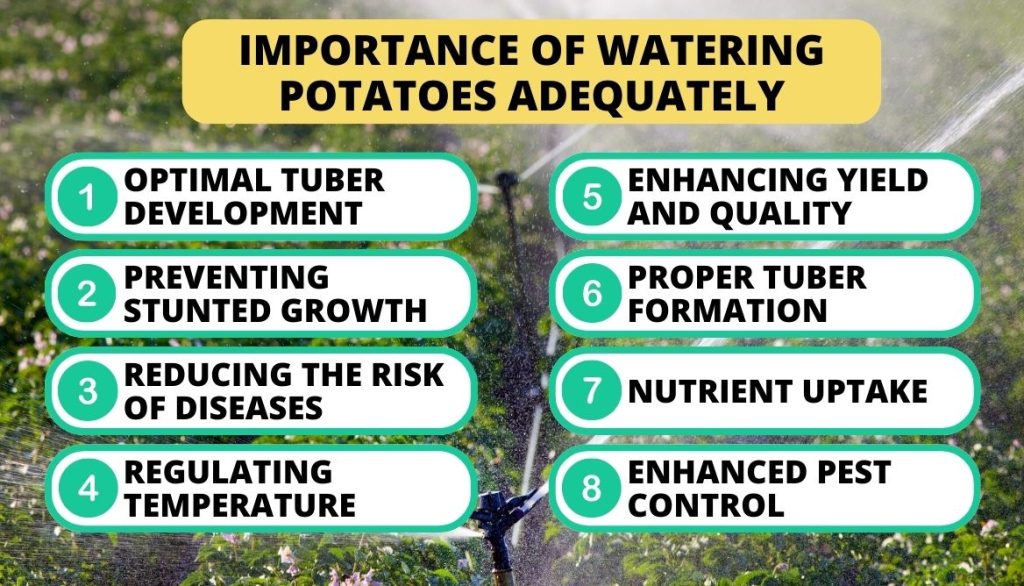
- Optimal tuber development: Potatoes primarily consist of water, and maintaining adequate soil moisture is essential for the formation and tuber growth. By providing enough water, you ensure the plants have the hydration necessary to produce plump and healthy tubers.
- Preventing stunted growth: Consistent watering helps promote the steady and healthy growth of potato plants. Water stress, either from too little or too much water, can stunt the growth of plants and lead to weak stems, small leaves, and overall reduced plant vigor.
- Reducing the risk of diseases: Proper watering practices can help minimize the occurrence of certain potato diseases. Overly dry conditions can lead to diseases like powdery scab and early blight. Overwatering can lead to waterlogged soil and diseases such as late blight and root rot.
- Regulating temperature: Watering can help regulate soil temperature, which is particularly important for potatoes. Proper irrigation can cool the soil during hot weather and prevent the plants from experiencing heat stress. Additionally, moisture in the soil helps maintain a more stable temperature, preventing drastic fluctuations that can impact potato growth.
- Enhancing yield and quality: Adequate watering practices are directly linked to higher potato yields and improved quality. Well-hydrated plants are more likely to produce healthier tubers, increasing overall yield.
- Proper Tuber Formation: Adequate watering ensures that potatoes form well-developed tubers. Insufficient moisture can lead to stunted growth and smaller tubers. When potato plants experience water stress, they tend to divert their energy towards survival rather than tuber development. As a result, you may end up with fewer and smaller potatoes.
- Nutrient Uptake: Water is vital in transporting nutrients from the soil to the roots and throughout the potato plant. It helps dissolve essential minerals and makes them available for absorption by the roots. Inadequate watering can limit nutrient uptake, leading to nutrient deficiencies and poor plant health.
- Enhanced Pest Control: Some pests, like potato beetles, thrive in dry conditions. By maintaining adequate moisture in the potato patch, you can discourage the establishment and proliferation of these pests. It also aids beneficial insects that prey on potato pests, creating a more balanced ecosystem in your garden.
What If You Keep Watering Your Potato Plants?
While it’s important to water potato plants adequately, excessive watering can negatively affect their growth and overall health. Here are some potential side effects of overwatering potato plants:
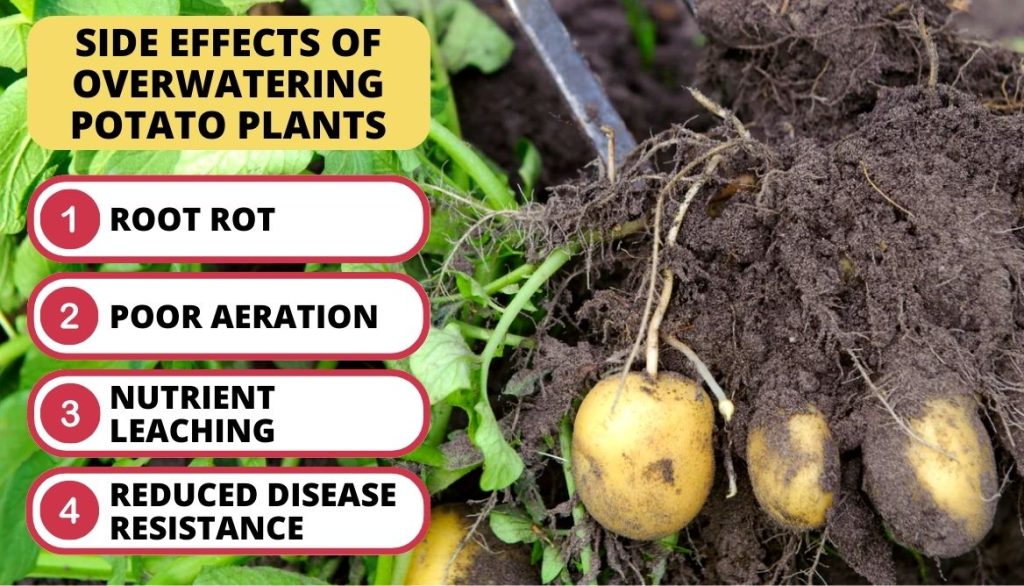
- Root rot: Overwatering can lead to waterlogged soil, which deprives the roots of necessary oxygen. The lack of oxygen creates a favorable environment for root rot pathogens, such as Pythium and Phytophthora, which can infect and damage the roots. Root rot can cause stunted growth, yellowing leaves, wilting, and even plant death.
- Poor aeration: Excess water in the soil hampers proper aeration, filling the air spaces between soil particles. Without adequate oxygen, the roots cannot function optimally. The lack of oxygen can inhibit nutrient uptake, weaken the plants, and reduce overall productivity.
- Nutrient leaching: Poor watering practices can cause nutrients to leach out of the soil. When there is excessive water, nutrients may be washed away from the root zone, making them unavailable to the plants. This can result in nutrient deficiencies and negatively impact the plant’s growth and development.
- Reduced disease resistance: Overwatered plants are more susceptible to certain diseases. The prolonged moisture on the leaves and stems can create a favorable environment for fungal diseases like late blight and early blight. These diseases can spread more easily in humid conditions, leading to leaf spots, rotting, and decreased plant health.
FAQ
Do potatoes need to be watered often?
Yes, potatoes require regular watering to ensure proper growth and yield. However, overwatering can lead to waterlogged soil and rot, so it’s important to maintain a balance.
How do you know if your potatoes are too much water?
If your potatoes are experiencing excessive water, the leaves may turn yellow and wilted, and the soil may become waterlogged or muddy. Additionally, the presence of rotting or decaying tubers indicates excessive moisture.
How long do potatoes take to grow?
Growing potato plants typically take around 70 to 120 days, depending on the variety and growing conditions. Early varieties can be ready for harvest in as little as 70 days, while maincrop varieties may take up to 120 days or more.
Can potatoes sit in water all day?
Potatoes should not sit in water all day as it can lead to rotting and soggy conditions. Excessive moisture can negatively impact the health and quality of the potatoes.
How to keep the soil moist when growing potatoes?
To keep the soil moist when growing potatoes, it is essential to water the plants consistently and deeply, ensuring that the water penetrates the root zone. Additionally, applying a layer of organic mulch, such as straw or compost, around the plants can help retain moisture in the soil and prevent evaporation.
How can I grow potato plants easily?
Obtain healthy seed potatoes from a garden store or online supplier to grow potato plants easily. Plant them in loose, well-draining soil, ensuring they receive ample sunlight and consistent moisture throughout their growth cycle.
How much water is in one potato?
A potato’s water can vary depending on its size and variety, but on average, potatoes contain about 70-80% water by weight. This high water content contributes to the moist and starchy texture of potatoes.
Conclusion
Proper watering is crucial for the successful growth of potatoes. By following the detailed planting guide, many gardeners can ensure that their potatoes receive the right amount of water at the right time.
Consistency is key, as over-watering can lead to disease and rot, while under-watering can result in stunted growth and reduced yields.
Have you tried additional watering techniques or strategies to grow potatoes that have yielded positive results? Share your experience in the comment below.
- How to Get Potatoes to Sprout Eyes: Detailed Growing Guide with 3 Options - July 31, 2023
- Weight of a Medium Potato: Revealed in Detailed Guide - July 29, 2023
- Maris Piper Potatoes: 9 Substitutes You Should Know About - July 27, 2023
Hello! I’m Jessica Zander, a garden coach and consultant based in the Boston area (zone 6b), offering virtual consultations across the country and Canada.
I’ve been passionate about gardening since the early 1990s, and in 2022, I launched You Can Do It Gardening to empower individuals to feel more confident in their gardening endeavors.
Following a 30-year career in nonprofit finance and operations, I transitioned out of that field in mid-June of 2023 due to the growing demand for coaching services. Interestingly, my years of presenting financial statements to boards and finance committees proved to be valuable experience for teaching people about gardening! I enjoy sharing skills, providing guidance and suggestions, and collaborating efficiently with clients to make significant improvements to their outdoor spaces, both small and large. I also regularly teach at the Arlington Continuing Education and Cambridge Adult Education.
My approach is direct and practical, akin to Mary Poppins, but tailored to your garden. Clients find satisfaction in saving money and taking pride in their own gardening achievements.

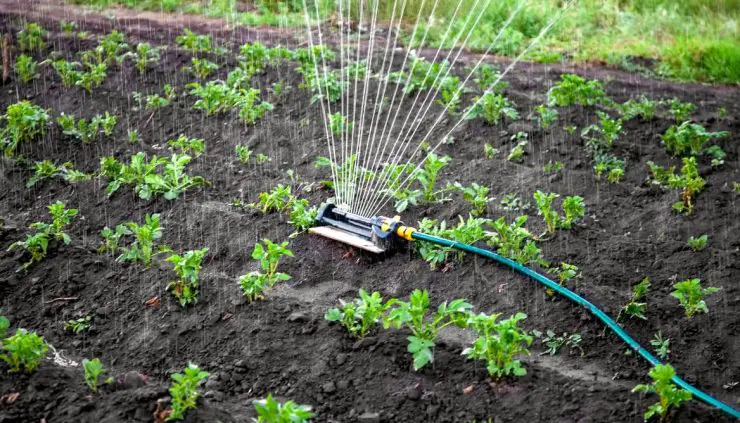
Add comment